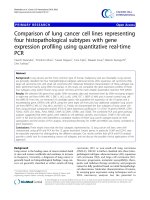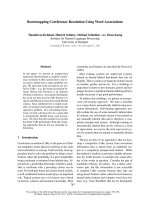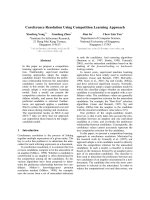optical nanolithography with 15 fold resolution using bowtie aperture array
Bạn đang xem bản rút gọn của tài liệu. Xem và tải ngay bản đầy đủ của tài liệu tại đây (611.81 KB, 5 trang )
Optical nanolithography with k/15 resolution using bowtie
aperture array
Xiaolei Wen
•
Luis M. Traverso
•
Pornsak Srisungsitthisunti
•
Xianfan Xu
•
Euclid E. Moon
Received: 23 October 2013 / Accepted: 16 January 2014
Ó Springer-Verlag Berlin Heidelberg 2014
Abstract We report optical parallel nanolithography
using bowtie apertures with the help of the interferometric-
spatial-phase-imaging (ISPI) technique. The ISPI system
can detect and control the distance between the bowtie
aperture, and photoresist with a resolution of sub-nano-
meter level. It overcomes the difficulties brought by the
light divergence of bowtie apertures. Parallel nanolithog-
raphy with feature size of 22 ± 5 nm is achieved. This
technique combines high resolution, parallel throughput,
and low cost, which is promising for practical applications.
1 Introduction
With the development of nanoscale science, nanofabrica-
tion technique needs to be continuously improved [1].
Higher resolution and throughput, lower cost, and simpli-
fication of system configuration are always the targets to
pursue. Among various types of nanofabrication methods,
such as electron beam lithography, nanoimprint lithogra-
phy [2], dip-pen lithography [3] and laser direct writing [4],
near-field optical lithography using metallic nano-apertures
or antennas is a promising technique due to its capacity of
sub-diffraction resolution, cost effective, and possibility of
parallel operation. In this type of lithography, sharp-ridged
apertures in metal, such as bowtie, C- and H-shaped
apertures and plasmonic lenses are important structures as
the optical focusing element due to its capability of pro-
ducing high confined light spots beyond the diffraction
limit with enhanced intensity in the near-field region [5–
10]. However, the transmitted light of the aperture is sub-
jected to strong divergence. The light emerging from the
exit plane is only collimated within tens of nanometers,
beyond which it diverges quickly and its intensity decrea-
ses significantly [11, 12]. Therefore, a precise distance
control between the aperture and the recording material
(i.e., the photoresist) is required to achieve stable and
repeatable sub-diffraction lithography patterns [6, 10, 13].
In this work, we combine a high precision dynamic gap
detection system named interferometric-spatial-phase-
imaging (ISPI), with a bowtie aperture-based nanolithog-
raphy system to realize high quality parallel nanolithog-
raphy. In this technique, substrates with photoresist are
scanned and exposed by light spots focused by bowtie
apertures fabricated in the Cr film-covered mask. Mean-
while, the ISPI system is used to measure the gap between
the mask and the substrate in real time. These two systems
work simultaneously due to different light incident geom-
etry. We demonstrate nanolithography with different
scanning speed and working distance under the control of
the ISPI system. A 5 9 5 parallel nanolithography with a
feature line width of about 22 nm is achieved with optimal
lithography parameters.
X. Wen Á L. M. Traverso Á P. Srisungsitthisunti Á X. Xu (&)
School of Mechanical Engineering and Birck Nanotechnology
Center, Purdue University, West Lafayette, IN 47907, USA
e-mail:
X. Wen
Department of Optics and Optical Engineering, The University
of Science and Technology of China, Hefei 230026, Anhui,
China
Present Address:
P. Srisungsitthisunti
Production Engineering Department, King Mongkut’s University
of Technology North Bangkok, Bangkok 10800, Thailand
E. E. Moon
Department of Electrical Engineering and Computer Science,
Massachusetts Institute of Technology, Cambridge, MA 02139,
USA
123
Appl. Phys. A
DOI 10.1007/s00339-014-8265-y
2 Interferometric-spatial-phase-imaging (ISPI)
The ISPI system is implemented to detect the distance
between the mask and the substrate, which provides a way
for fine alignment and gap control during the lithography
process [14]. The gap detection is based on analysis of
phase and frequency information of the interference fringes
produced by the ISPI gratings [15–17]. As Figs. 1 and 2c, d
show, the ISPI gratings consist of a pair of two-dimen-
sional checkerboards, each of which has an overall size of
280 9 20 lm. The checkerboard is composed of periodi-
cally arranged squares, whose size and interval are uniform
along the y-direction but chirped along the x-direction. The
two adjacent checkerboards are chirped in opposite direc-
tions. The incident beam is in the y–z plane, and the y-
periodicity of the checkerboard is designed to diffract the
beam back to the ISPI scope. The chirped x-periodicity is
used to produce diffraction beams with a sweep of angles
in x–z plane. The beams further interfere with each other
and create a set of fringes on the imaging plane of the ISPI
scope. The position and number of the fringes are sensitive
to the gap between the mask and substrate. By analyzing
the fringes from the adjacent two checkerboards, we can
obtain the frequency and phase shift information, which is
used to derive the gap value.
With use of ISPI frequency gapping, we achieved a
parallelism within 0.03 mrad. That means over a
200 9 200 lm
2
area, the gap difference is smaller than
6 nm. On the other hand, the phase gapping is not affected
by the Fabry–Perot effect, which is more reliable and
accurate than frequency gapping. From calibration, the
Fig. 1 Schematic diagram of the nanolithography setup. Inset is the
sketch of ISPI gratings
Fig. 2 a Sketch of the mask
used for the nanolithography,
b SEM image of the island
milled with a 5 9 5 bowtie
array (the bowties are marked
by white circles). Inset is a
zoom-in image of a bowtie
aperture. c SEM image of ISPI
gratings, d zoom-in image of
the square area in (c)
X. Wen et al.
123
sensitivity of phase gapping is found to be smaller than
0.5 nm based on our signal detection system.
3 Experimental setup
The experimental setup of near-field nanolithography is
built in a semi-closed glove box to reduce contamination. It
is composed of gap detection system, ISPI, and the
lithography exposure system (Fig. 1). The ISPI system is
mounted at an oblique angle so that it does not interfere
with the normal-incident exposure beam. The ISPI scope
with a 660-nm-wavelength fiber laser is fixed to a six-axis
control stage, which can adjust the scope and laser to
capture the ISPI images reflected from gratings on the
mask. The position and orientation of ISPI scope are
aligned carefully for an accurate detection.
A frequency-tripled diode-pumped solid-state UV laser
(wavelength 355 nm, pulse width *25 ns, repetition rate
30 kHz) is utilized as an exposure source for our lithog-
raphy. The mask is held on a piezo-electric stage which can
change its tip–tilt angle for alignment with respect to the
substrate. The mask structure is shown in Fig. 2a. We use a
piece of 0.5
00
square quartz, covered by a 70-nm-thick Cr
layer. On the sides of the mask, several sets of ISPI grat-
ings were fabricated by electron beam lithography––EBL.
In the center of the mask, there are islands with bowtie
arrays fabricated on the top (Fig. 2b). The island is used to
reduce the contact area between the mask and the photo-
resist surfaces, thus to reduce the possibility of contami-
nation and friction. The bowties with outline dimension of
190 9 190 nm are milled by FIB.
Shipley S1805 photoresist was spun on a quartz sub-
strate at 4,500 rpm giving a thickness of 400 nm. The
substrate is held on another 5-axis piezo-electric stage
which can move in x, y and z directions with a resolution of
0.4 nm and also adjust the tip–tilt angle for alignment.
Development was performed using a standard mix of 351
developer and DI water with a ratio of 1:3 for 7 s.
4 Results and discussion
Static tests were first performed with the bowtie apertures to
determine a proper exposure dose for the photoresist S1805
we are using. Figure 3 shows AFM images of spots formed
from different exposure time under an incident power
density of about 10 mW/cm
2
. When the time is more than
2 s, the spot size exceeds 300 nm, which indicates over-
exposure. Under the time of 2 s, the size and depth of the
spot decreases with the exposure time. With the time of
0.2 s, the spot can just be distinguished. The threshold of the
photoresist is found to be around 2 mJ/cm
2
.
The lithography system was then used to produce line
patterns by moving the photoresist relative to the fixed
exposing source, i.e., the bowtie apertures. Since the
effective working distance of bowtie apertures is only tens
Fig. 3 AFM image of static lithography tests with different exposing
time
Fig. 4 a AFM image of line pattern produced by moving photoresist,
b a cross-sectional scan of the pattern taken from the position
illustrated in the inset
Optical nanolithography with k/15 resolution
123
of nanometers, there is a strict requirement on the align-
ment and gap control of the lithography system to obtain
high quality sub-diffraction patterns. With the help of ISPI,
we can dynamically detect the distance between the mask
and substrate for alignment. It also provides a precise
control on approaching the photoresist substrate to the
bowtie apertures, which not only prevents too much pres-
sure and friction caused by contact, but also ensures that
the photoresist surface locates within the sub-50 nm near-
field of the bowtie apertures. Figure 4 shows the AFM
image of a line pattern produced with a substrate scanning
speed of 1 lm/s. The full width at half maximum (FWHM)
measured from the cross-sectional scan in Fig. 4b is 43 nm.
To investigate the variance in FWHM, we randomly took
ten cross-sectional scans on the image and obtained an
averaged FWHM *45 nm with a standard deviation of
6 nm. This line width is much smaller than the overall
dimension of the bowtie aperture, but is corresponding to
the gap size between the two tips, illustrating light con-
finement by the bowtie apertures.
By further adjusting the laser power and the gap dis-
tance, the smallest line width (FWHM) achieved is
* 22 ± 5 nm (Fig. 5), which is about 1/15th of the light
wavelength that we used for exposure. In this case, a 5 9 5
bowtie array was used as optical focusing elements. With
light exposure, 25 patterns were produced simultaneously.
As the AFM image is shown in Fig. 5a, these 25 patterns
are uniform, due to the alignment provided by the ISPI
technique. It is anticipated that further increasing the
number of bowtie apertures in the array will significantly
increase the efficiency of nanolithography.
5 Conclusion
For near-field bowtie-aperture optical nanolithography, we
implemented an ISPI system into the nanolithography
system for gap detection and control on the sub-nanometer
level. It is shown that with the help of ISPI, we are able to
achieve high quality lithography patterns with feature size
as small as 22 ± 5 nm. A 5 9 5 bowtie array parallel
lithography is also performed, which indicates that this
technique has a potential for increasing the efficiency of
nanolithography.
Fig. 5 a AFM images of 5 9 5
bowtie array parallel
lithography, b one unit of the
pattern, c cross-sectional scan of
the pattern taken from the
position illustrated in the inset.
Inset is the zoom-in image of
the square area in (b)
X. Wen et al.
123
Acknowledgments Support to this work by the Defense Advanced
Research Projects Agency (Grant No. N66001-08-1-2037) and the
National Science Foundation (Grant No. CMMI-1120577) is grate-
fully acknowledged. X.W. also acknowledges the support from the
National Basic Research Program (973 Program) of China under
Grant No. 2013CBA01703 and 2012CB921900.
References
1. Z. Xie, W. Yu, T. Wang, H. Zhang, Y. Fu, H. Liu, F. Li, Z. Lu, Q.
Sun, Plasmonics 6, 565 (2011)
2. S.Y. Chou, P.R. Krauss, P.J. Renstrom, Appl. Phys. Lett. 67,
3114 (1995)
3. D.L. Wilson, R. Martin, M. Cronin-Golomb, C.A. Mirkin, D.L.
Kaplan, Microsc. Microanal. 8, 1020 (2002)
4. J.I. Mitchell, S.J. Park, C.A. Watson, P. Srisungsitthisunti, C.
Tansarawiput, M. Qi, E.A. Stach, C. Yang, X. Xu, Opt. Eng. 50,5
(2011)
5. L. Pan, Y. Park, Y. Xiong, E. Ulin-Avila, Y. Wang, L. Zeng, S.
Xiong, J. Rho, C. Sun, D.B. Bogy, X. Zhang, Sci. Rep. 1, 175
(2011)
6. T. Kim, W.S. Lee, H.E. Joe, G. Lim, G.J. Choi, M.G. Gang, S.M.
Kang, K.S. Park, B.K. Min, Y.P. Park, N.C. Park, Appl. Phys.
Lett. 101, 161109 (2012)
7. Y. Kim, S. Kim, H. Jung, J.W. Hahn, Proc. SPIE 7637, 76371F
(2010)
8. L. Wang, S.M. Uppuluri, E.X. Jin, X. Xu, Nano Lett. 6, 361
(2006)
9. S.M.V. Uppuluri, E.C. Kinzel, Y. Li, X. Xu, Opt. Exp. 18, 7369
(2010)
10. N. Murphy-DuBay, L. Wang, X. Xu, Appl. Phys. A 93, 881
(2008)
11. E.X. Jin, X. Xu, Jpn. J. Appl. Phys. 43, 407 (2004)
12. P. Srisungsitthisunti, O.K. Ersoy, X. Xu, Appl. Phys. Lett. 98,
223106 (2011)
13. W. Srituravanich, L. Pan, Y. Wang, C. Sun, D.B. Bogy, X.
Zhang, Nat. Nanotechnol. 3, 733 (2008)
14. X.L. Wen, L.M. Traverso, P. Srisungsitthisunti, X. Xu, E.E.
Moon, J. Vac. Sci. Technol. B 31, 041601 (2013)
15. E.E. Moon, L. Chen, P.N. Everett, M.K. Mondol, H.I. Smith, J.
Vac. Sci. Technol. B 21, 3112 (2003)
16. E.E. Moon, P.N. Everett, M.W. Meinhold, M.K. Mondol, H.I.
Smith, J. Vac. Sci. Technol. B 17, 2698 (1999)
17. P. Srisungsitthisunti, E.E. Moon, C. Tansarawiput, H. Zhang, M.
Qi, X. Xu, Proc. SPIE 7767, 776707 (2010)
Optical nanolithography with k/15 resolution
123









